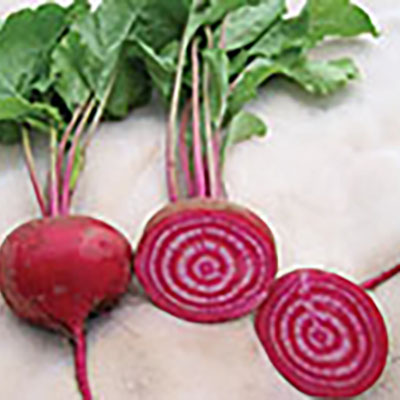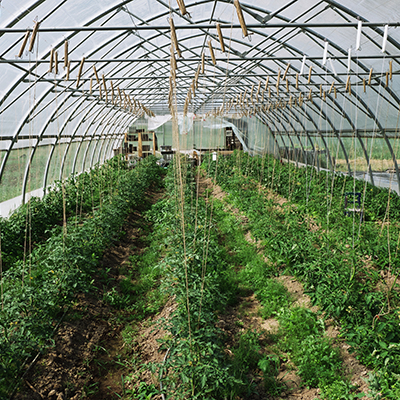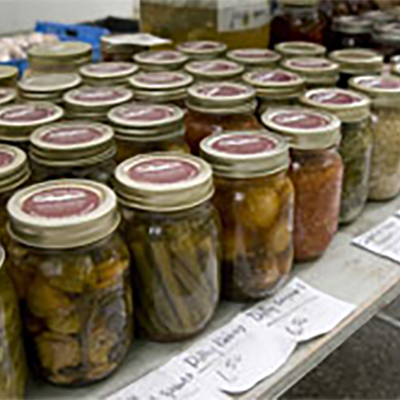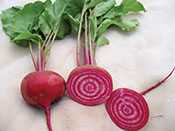Growing for Market in partnership with Johnny's Selected Seeds has created a library of expert information about growing and selling vegetables and flowers. Links in the article will take you to johnnyseeds.com.
Subscribe to Growing for Market for more great ideas about growing and marketing!
For more topics in the series, click on Market Farming Basics in the left column.

Autumn can be a profitable season for local growers, but it requires a lot of planning far in advance to get a good crop mix in sufficient volume. Many of the best fall crops — think pumpkins and Brussels sprouts — take more than 100 days to mature. That means spring is the time to analyze potential markets, schedule plantings, and order seeds. In this issue of the JSS Advantage, we’ll suggest crops that will keep you selling at least until Thanksgiving.
Pumpkins: It used to be that you couldn’t sell a pumpkin after October 31 because virtually all consumer interest focused on Halloween. That certainly has been changing in recent years, thanks to pumpkin varieties that are great for cooking and decorating. Chefs and other foodies have embraced pumpkins as a delicious winter ingredient. Magazine editors feature recipes for pumpkin soups, stews, roasts, and seeds. Even some beer drinkers are pumpkin fans, thanks to the many microbreweries that make a special autumn ale with fresh or roasted pumpkin puree.
So if you do grow pumpkins, think outside the Halloween box. Grow several kinds of pumpkins and be prepared to promote them with recipes, nutrition information, and decorating ideas.
Pumpkins are basically divided into three categories: Jack-o’-Lanterns, pie, and specialty/ornamental. There’s lots of crossover among the categories, though; many varieties in all three categories are great for eating, and all pumpkins are good looking enough to be used as ornamentals.
In choosing Jack-o’-Lantern varieties, consider your markets first. What size do your customers want? If you sell at a farmers market, they may not want big pumpkins because of the difficulty of transporting them to their cars. If you have a roadside stand, bigger may be better because they are more visible from the road. If you have a U-Pick and cater to school groups, you need small pumpkins (under 10 lb.) so children can carry them. If you offer painted pumpkins, you may prefer smooth-skinned, rather than ribbed, pumpkins. If you hope to wholesale pumpkins, consult with your prospective buyers early to learn their preferences.
Johnny’s comparative table of Jack-o’-Lantern varieties spells out these important differences and more to help you choose the best varieties for your markets.
Specialty pumpkins offer opportunities to sell beyond Halloween. Johnny’s selection includes pumpkins of many hues, shapes, and characteristics. Offer several types to encourage multiple purchases. Show some hollowed out and used as containers for Thanksgiving table arrangements. Cut open the most preferred varieties for eating to show their bright flesh. Johnny’s specialty pumpkin comparative table will help you sort through the many colorful options.
As for pie pumpkins, they will sell themselves if you provide exciting recipes. A stuffed pumpkin makes a spectacular side dish or vegetarian alternative to turkey at Thanksgiving. Black bean and pumpkin stew is great served with cornbread or in tortillas. Creamy pumpkin soup is an easy and elegant addition to an autumn meal. And don’t forget the roasted pumpkin seed recipes! Johnny’s has two varieties that have either hulless (Kakai) or semi-hulless (Baby Bear) seeds for the best pepitas.
The comparative charts also are helpful in calculating how much to plant. Pumpkins vary widely in their yield and space requirements; Jack-o’-Lanterns need anywhere from 18 to 36 square feet per plant and average yield can be 1-3 fruits per plant. Some specialty pumpkins may produce only two or three fruits per plant whereas others may average 10.
If you are earnest about growing pumpkins, we recommend the Pumpkin Production Guide, a thorough book about all aspects of the crop, including varieties, economics, insects and diseases, cultural requirements, and marketing.
Winter squash
Winter squash are closely related to pumpkins (many are the same species, in fact) and are grown for their eating qualities. Their star is also rising in the culinary world, and people are getting familiar enough with them to have preferences. So it makes sense to grow several different kinds. They can be broadly divided into the acorns, delicatas, butternuts and buttercups, kabochas, and hubbards. All have sweet flesh that improves in flavor with a few weeks to a few months of storage.
Storage life of winter squash varies. In general, butternut and buttercup types last the longest when properly stored, up to 6 months. Hubbard and kabocha types will hold for 4 to 6 months. Delicata and dumpling squash will hold 3 to 5 months. Acorns have the shortest storage life, at about 2 months, so should be sold first.
Ornamentals
If you are going to be selling pumpkins, you can increase your average sale by offering other fall ornamentals. Gourds are a natural companion to pumpkins, offering autumnal colors and arresting shapes. They range from small fruited gourds for a tabletop display to giant gourds that can sit on a porch with the pumpkins. Bottle and birdhouse gourds are also popular in fall, especially among crafters.
Consider drying flowers to sell in bunches or bouquets. If you grow cut flowers in summer, harvest some extras every week and hang them to dry in a hot barn or shed. By autumn, you’ll have a great inventory of dried flowers. These flowers are useful as fresh flowers in summer and are super easy to dry by hanging upside down: amaranths, bells of Ireland, bupleurum, celosia, carthamus, craspedia, eucalyptus, gomphrena, larkspur, nigella, salvia, statice, and strawflower.
Some grasses and grains can be dried and saved for fall sales: ornamental corn, broom corn, eragrostis, millet, rye, and wheat.
Sunflowers are eye-catching additions to a fall market display, and they are easy to schedule. They are frost-tender, though, so you will have to either grow them before frost or grow them in a hoophouse. The best varieties for fall blooms are daylength neutral: ProCut series, which take 50-60 days to bloom; the Sunrich series, 60-70 days; and Sunbright Supreme, 60-70 days.
Finally, consider growing some potted plants for fall sales. Mums are popular, but common. To offer something different, consider potted sunflowers or ornamental peppers. Potted herbs are another good value because customers can bring them inside as the weather gets cold.
Brassicas
Round out your autumn offerings with a good selection of cold-tolerant brassicas. Brussels sprouts need to be started in early summer for fall harvest. Broccoli, cabbage and kale can be started in late summer to mature during the cool days of autumn. See Johnny’s broccoli comparison chart for help in choosing the best varieties for fall sales.
Visit Johnny's Selected Seeds for more free information about growing produce, herbs, cover crops and flowers.
Subscribe to Growing for Market for the latest news and ideas.
Reprinted from JSS Advantage April 2012




 Among successful market farms, there is a trend toward diversification and away from specialization. As growers gain experience, they tend to add new crops and markets and extend their seasons. They find ways to maximize income from everything they grow and put all their land to good use.
Among successful market farms, there is a trend toward diversification and away from specialization. As growers gain experience, they tend to add new crops and markets and extend their seasons. They find ways to maximize income from everything they grow and put all their land to good use.


 August can be a busy month. Summer crops are at their peak and fall crops need attention. It's time to look ahead to fall and winter markets. Yet, it may still be so hot you just don't want to do anything! We'll suggest some practical ideas and, we hope, provide some encouragement to keep you going.
August can be a busy month. Summer crops are at their peak and fall crops need attention. It's time to look ahead to fall and winter markets. Yet, it may still be so hot you just don't want to do anything! We'll suggest some practical ideas and, we hope, provide some encouragement to keep you going.